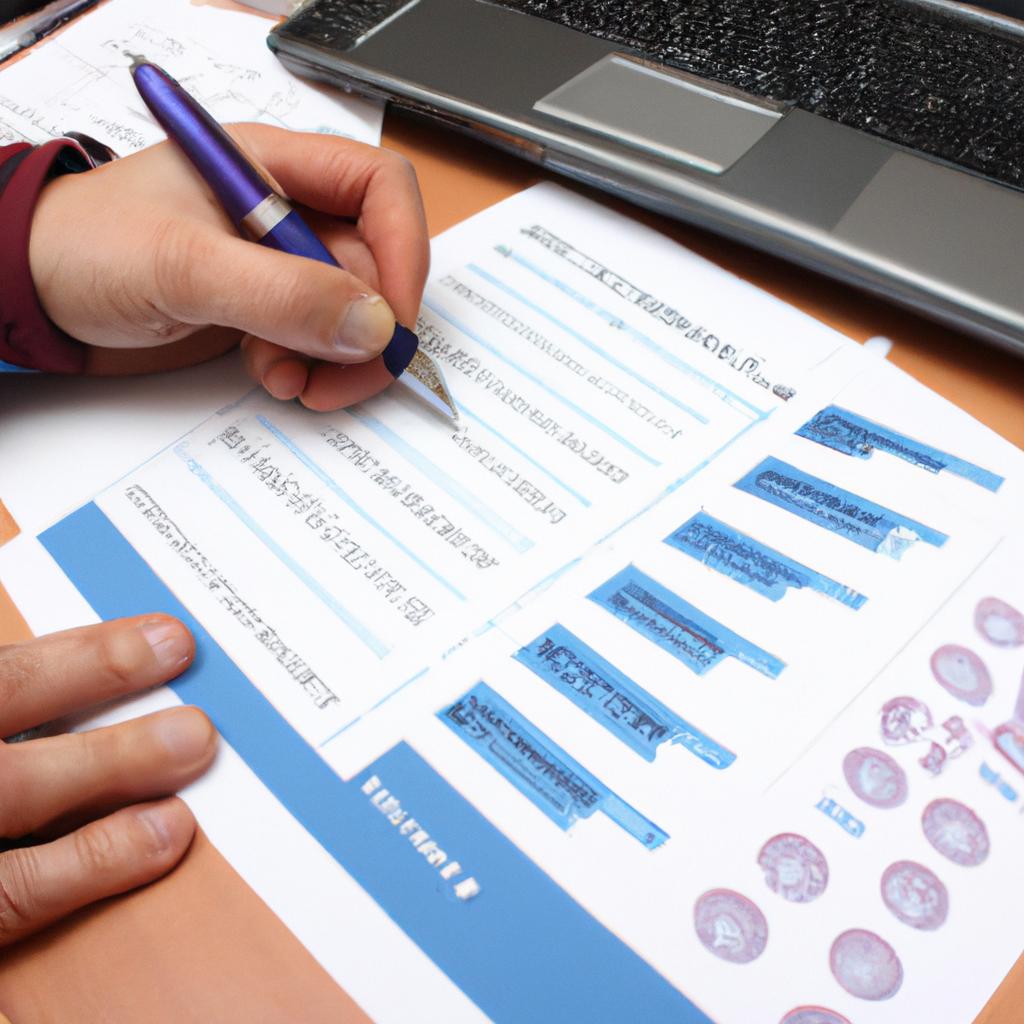Healthcare Expenses: Body Myositis and Medical Finance

Healthcare expenses pose a significant financial burden on individuals and their families, particularly when faced with complex medical conditions such as body myositis. Body myositis is a rare autoimmune disease that affects the muscles, leading to progressive weakness and functional impairment. The cost of managing this condition can be exorbitant, involving various healthcare services, medications, and rehabilitative therapies. This article aims to explore the intricate relationship between body myositis and medical finance by examining the challenges individuals face in accessing affordable care and discussing potential strategies to alleviate the financial strain.
To illustrate the impact of healthcare expenses on those diagnosed with body myositis, consider the hypothetical case of Sarah, a 45-year-old woman living with this debilitating illness. Sarah’s journey began with persistent muscle weakness and fatigue, prompting her to seek medical attention. After multiple visits to different specialists and an array of diagnostic tests, she was finally diagnosed with body myositis. However, this diagnosis came at a significant cost – consultations fees, laboratory investigations, imaging studies – all adding up to an overwhelming sum. As Sarah embarks on her treatment plan encompassing immunosuppressive therapy sessions along with regular physical therapy appointments for rehabilitation purposes, she realizes that these ongoing expenses will continue throughout her life and pose a significant financial burden. The cost of medications for body myositis can be substantial, especially considering the need for long-term use of immunosuppressive drugs to manage the condition. Additionally, regular physical therapy sessions are essential to maintain muscle function and prevent further deterioration, adding to the ongoing healthcare expenses.
The financial strain becomes even more challenging when considering that individuals with body myositis may face limitations in their ability to work due to the progressive nature of the disease. This loss of income combined with increased healthcare costs creates a double-edged sword, making it even more difficult for patients like Sarah to afford necessary medical care.
One potential strategy to alleviate the financial burden is through health insurance coverage. However, not all health insurance plans fully cover the costs associated with body myositis treatment. Patients may encounter high deductibles, co-pays, and limitations on certain services or medications. It is crucial for individuals diagnosed with body myositis to thoroughly review their insurance policies and understand what expenses will be covered and what they will be responsible for out-of-pocket.
In addition to health insurance, patients can explore other avenues for financial assistance. Patient assistance programs offered by pharmaceutical companies may provide discounts or free medications to eligible individuals who cannot afford them otherwise. Non-profit organizations dedicated to supporting patients with rare diseases like body myositis may also offer grants or financial aid programs.
Furthermore, individuals can seek guidance from social workers or patient advocacy groups who specialize in navigating the complexities of medical finance. These professionals can help identify resources and programs that can assist with managing healthcare expenses related to body myositis.
Lastly, proactive communication between patients and their healthcare providers is vital in addressing concerns about affordability. Physicians may be able to recommend alternative treatment options or suggest cost-saving measures without compromising the quality of care.
In conclusion, managing body myositis comes with significant healthcare expenses that pose a considerable financial burden on affected individuals and their families. Accessing affordable care can be challenging, but exploring health insurance coverage, patient assistance programs, and seeking guidance from professionals can help alleviate the financial strain. Open communication with healthcare providers is also crucial in finding cost-effective solutions without compromising the quality of treatment.
Understanding Body Myositis
Imagine a vibrant, active individual named Emily who suddenly finds herself experiencing muscle weakness and fatigue. She struggles to perform daily tasks that were once effortless, such as climbing stairs or lifting objects. After seeking medical help, she receives a diagnosis of body myositis – a rare autoimmune disorder characterized by inflammation of the muscles.
Body myositis is an uncommon condition that affects both children and adults. The exact cause remains unknown, although researchers believe it may involve genetic factors and abnormalities in the immune system. This chronic illness can significantly impact an individual’s quality of life and lead to various physical limitations.
Living with body myositis poses several challenges:
- Physical Limitations: Muscle weakness, pain, and stiffness make even simple movements difficult for those affected by this condition.
- Emotional Impact: Coping with chronic pain and the loss of independence can take a toll on mental well-being.
- Financial Burden: Medical expenses associated with treating body myositis can be substantial, including doctor visits, medications, specialized therapies, assistive devices, and potential hospitalizations.
- Social Isolation: Physical limitations may restrict participation in social activities or hobbies, leading to feelings of isolation.
To further understand the implications of living with body myositis, consider the following table:
| Challenge | Impact |
|---|---|
| Physical Limitations | Difficulty performing daily tasks |
| Emotional Impact | Mental strain due to chronic pain |
| Financial Burden | High healthcare costs |
| Social Isolation | Limited engagement in social activities |
In conclusion, body myositis presents unique challenges that affect not only physical health but also emotional well-being and financial stability.
[Transition] Moving forward, let us explore “The Impact of Body Myositis on Health” and delve deeper into the consequences of this condition.
The Impact of Body Myositis on Health
Understanding Body Myositis and Its Impact on Health
Imagine a middle-aged woman named Sarah, who has been living with body myositis for the past five years. This chronic autoimmune disease causes inflammation in her muscles, leading to weakness, pain, and fatigue. Despite undergoing various treatments and therapies, Sarah continues to struggle with everyday activities that were once effortless. Her condition not only affects her physical well-being but also takes a toll on her mental and emotional state.
Living with body myositis can be challenging both physically and financially. The impact of this debilitating disease extends beyond its symptoms, affecting individuals’ overall health and quality of life. To comprehend the significance of managing healthcare expenses associated with body myositis, consider the following points:
- Financial burden: The cost of treating body myositis can be substantial, including expenses related to medication, doctor visits, physical therapy sessions, and specialized equipment such as mobility aids or assistive devices.
- Insurance coverage limitations: Despite having insurance coverage, individuals with body myositis may encounter hurdles in obtaining reimbursement for certain treatments or medications. Some insurance plans have restrictions on specific drugs or therapies deemed experimental or investigational.
- Reduced work productivity: Due to their physical limitations and fluctuating energy levels caused by body myositis, individuals may experience difficulties maintaining regular employment or achieving career advancement. This can lead to reduced income and additional financial strain.
- Emotional distress: Coping with a chronic illness like body myositis can result in heightened stress levels, anxiety about future medical costs, feelings of isolation due to limited social interactions, and an increased reliance on support networks.
To further understand the multifaceted impact of body myositis on health outcomes, let’s explore how it affects different aspects of an individual’s well-being through the following table:
| Aspect | Impact |
|---|---|
| Physical Well-being | – Muscle weakness and pain- Fatigue affecting daily activities |
| Mental Health | – Increased stress and anxiety- Emotional distress due to limitations |
| Social Interactions | – Limited participation in social events or gatherings- Feelings of isolation |
| Financial Stability | – High healthcare costs leading to financial strain- Reduced work productivity |
Managing the expenses associated with body myositis is crucial for individuals like Sarah, who strive to maintain a good quality of life despite their condition.
[Transition into the subsequent section about “Managing Expenses Associated with Body Myositis”] By understanding the impact of body myositis on health and recognizing the financial burdens it imposes, individuals can take proactive steps towards managing their expenses without compromising their well-being.
Managing Expenses Associated with Body Myositis
Section: Managing Healthcare Expenses Associated with Body Myositis
Introduction
In the previous section, we explored the impact of body myositis on health. Now, let us delve into an equally crucial aspect associated with this condition – managing healthcare expenses. To better understand the challenges individuals face in financing their medical needs, consider the case of Sarah, a 40-year-old woman diagnosed with body myositis.
Sarah’s Case Study
Sarah was leading an active life until she started experiencing muscle weakness and fatigue. After multiple doctor visits and diagnostic tests, she received a diagnosis of body myositis. As she embarked on her treatment journey, Sarah faced numerous financial hurdles due to expensive medications, frequent hospitalizations, and additional therapies required for managing her symptoms effectively.
Challenges Faced by Individuals with Body Myositis
- Financial Strain: The cost of treating body myositis can be overwhelming for individuals like Sarah who may not have sufficient insurance coverage or access to adequate financial resources.
- Medication Expenses: Medications prescribed for body myositis management are often costly and may require long-term usage.
- Hospitalization Costs: Hospital stays become necessary at times to monitor disease progression or administer specialized treatments.
- Additional Therapies: Physical therapy, occupational therapy, and other supportive interventions add to the overall healthcare expenses.
To illustrate these challenges more comprehensively:
| Challenges | Impact |
|---|---|
| Financial strain | Emotional stress |
| Medication expenses | Limited affordability |
| Hospitalization costs | Increased financial burden |
| Additional therapies | Reduced quality of life |
Exploring Available Healthcare Options
As we move forward in our discussion on managing healthcare expenses related to body myositis, it is imperative that we explore available options that can alleviate some of these financial burdens while ensuring optimal care for individuals affected by this condition.
[Transition sentence]: In the subsequent section, we will delve into potential strategies and resources that can assist individuals with body myositis in navigating their healthcare options effectively.
By addressing the financial challenges associated with body myositis, individuals like Sarah can focus on their health without compromising their overall well-being.
Exploring Available Healthcare Options
Consider the case of Sarah, a 35-year-old woman diagnosed with body myositis. As she grapples with this chronic muscle inflammation condition, Sarah finds herself facing significant financial burdens associated with her medical care. In this section, we will explore various strategies for managing healthcare expenses related to body myositis and highlight available healthcare options.
Strategies for Managing Healthcare Expenses:
To effectively manage healthcare expenses linked to body myositis, it is crucial to consider the following key strategies:
-
Insurance Coverage: Understanding your insurance policy and its coverage provisions can significantly impact your ability to navigate medical costs. Investigate whether your policy covers necessary treatments, medications, hospital stays, or specialized therapies specific to body myositis. If certain aspects are not covered, research alternative policies that may better suit your needs.
-
Financial Assistance Programs: Many organizations offer financial assistance programs specifically designed to aid individuals coping with chronic conditions like body myositis. These programs provide grants or subsidies to help cover medical bills or additional expenses arising from treatment. Researching such resources within your community can alleviate some of the financial burden associated with ongoing care.
-
Budgeting and Cost Comparison: Creating a comprehensive budget that accounts for all anticipated medical expenses is an essential step in navigating healthcare costs. Consider exploring cost comparison tools provided by hospitals or clinics to make informed decisions about where you receive treatment while minimizing out-of-pocket expenditures.
-
Fundraising Platforms: Engaging friends, family members, and even acquaintances through crowdfunding platforms can be a viable option when dealing with substantial medical expenses. Sharing your story on these platforms allows people who sympathize with your situation to contribute financially towards your cause.
Emotional Impact Table:
| Emotional Response | Examples |
|---|---|
| Stress | Uncertainty regarding future medical costs |
| Anxiety | Balancing treatment expenses with daily life obligations |
| Frustration | Limited availability of affordable treatment options |
| Relief | Discovering financial assistance programs tailored to body myositis patients |
By implementing these strategies and exploring available resources, individuals coping with body myositis can better manage the financial strain associated with their healthcare needs.
Tips for Financial Planning in Medical Situations
When faced with a diagnosis of body myositis, individuals often find themselves navigating through the complex world of healthcare options. It is imperative to understand the available avenues for medical care and financial support in order to ensure comprehensive treatment. To illustrate this point, let us consider a hypothetical case study:
Sarah, a 45-year-old woman diagnosed with body myositis, recently found herself overwhelmed by the high costs associated with her medical expenses. She quickly realized that exploring different healthcare options was crucial to managing her condition effectively.
To assist individuals like Sarah in their journey towards finding appropriate healthcare options, here are some key considerations:
- Insurance Coverage: Review your insurance policy thoroughly to determine what services and treatments are covered under your plan. Be aware of any limitations or restrictions that may affect access to specialized care.
- Government Programs: Investigate if you qualify for government assistance programs such as Medicaid or Medicare, which can provide additional financial support for those facing significant healthcare expenses.
- Clinical Trials: Explore opportunities to participate in clinical trials focused on developing new treatments for body myositis. Not only can these trials offer potential cutting-edge therapies, but they may also cover certain medical expenses.
- Nonprofit Organizations: Seek out nonprofit organizations dedicated to supporting patients with body myositis. These organizations often provide grants, financial aid, or resources specifically tailored to help alleviate the burden of medical costs.
Table: Financial Assistance Resources for Body Myositis Patients
| Organization Name | Services Offered |
|---|---|
| Muscular Dystrophy Association (MDA) | Financial aid for medical equipment and supplies |
| National Organization for Rare Disorders (NORD) | Grants and scholarships for medication and treatment-related expenses |
| The Assistance Fund | Co-pay assistance programs |
| Patient Access Network Foundation | Financial assistance for insurance premiums |
By exploring these various avenues, individuals like Sarah can take important steps towards managing their healthcare expenses effectively. While the financial burden can be daunting, it is essential to remember that support and resources are available.
Transitioning into the subsequent section on “Support and Resources for Body Myositis Patients,” individuals facing body myositis can find comfort in knowing that they are not alone on this journey. It is through accessing these support systems that patients can gain valuable information and assistance to navigate their medical challenges more successfully.
Support and Resources for Body Myositis Patients
Having discussed the importance of financial planning in medical situations, it is crucial to explore the support and resources available specifically for individuals diagnosed with body myositis. This autoimmune disease can present significant challenges not only to one’s physical well-being but also to their financial stability. By understanding the various assistance options, patients can alleviate some of the burdens associated with healthcare expenses.
Support Organizations:
One example of an organization that offers support to body myositis patients is The Myositis Association (TMA). TMA provides a range of services such as informational resources, educational materials, and support groups designed to connect patients and caregivers facing similar challenges. Additionally, they offer financial aid programs that provide grants or assistance with medication costs based on individual needs.
Emotional Impact:
- Coping with chronic pain and fatigue
- Managing decreased mobility and independence
- Navigating complex healthcare systems
- Balancing work-life responsibilities while dealing with symptoms
Financial Assistance Programs:
Table 1 showcases three notable financial assistance programs available for body myositis patients:
| Program Name | Eligibility Criteria | Benefits Offered |
|---|---|---|
| Patient Access Network Foundation | U.S. residents | Helps cover prescription co-pays |
| HealthWell Foundation | U.S. citizens or legal residents | Assists with insurance premiums |
| NeedyMeds | Varies depending on program | Offers discounted medications through partnerships |
Through these organizations’ initiatives, individuals affected by body myositis can obtain much-needed financial relief when faced with costly medical treatments and prescriptions.
Concluding Thoughts:
Accessing resources that provide support, education, and financial assistance is essential for individuals diagnosed with body myositis. By connecting with organizations like The Myositis Association (TMA) and exploring programs such as those mentioned in Table 1, patients can ease the burden of healthcare expenses while gaining emotional support from others facing similar challenges. It is crucial to take advantage of these available resources to promote well-being throughout the journey of living with body myositis.






